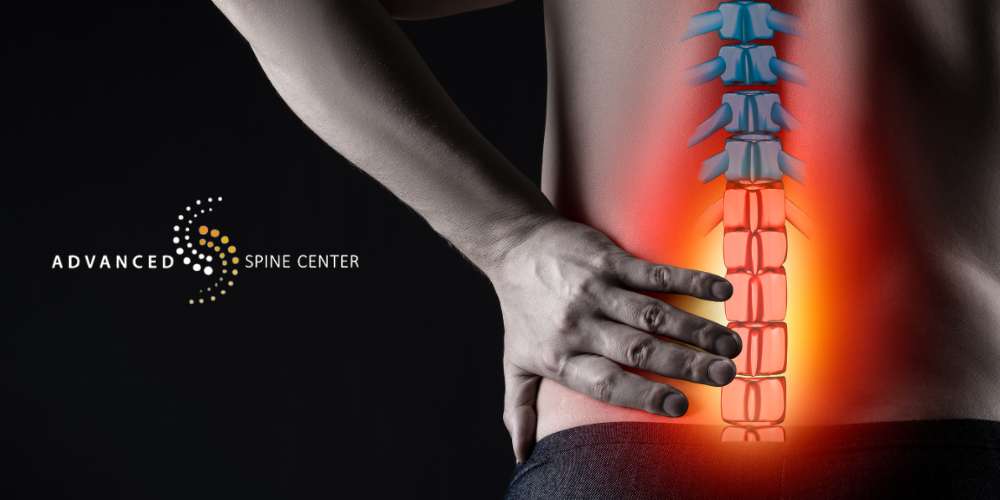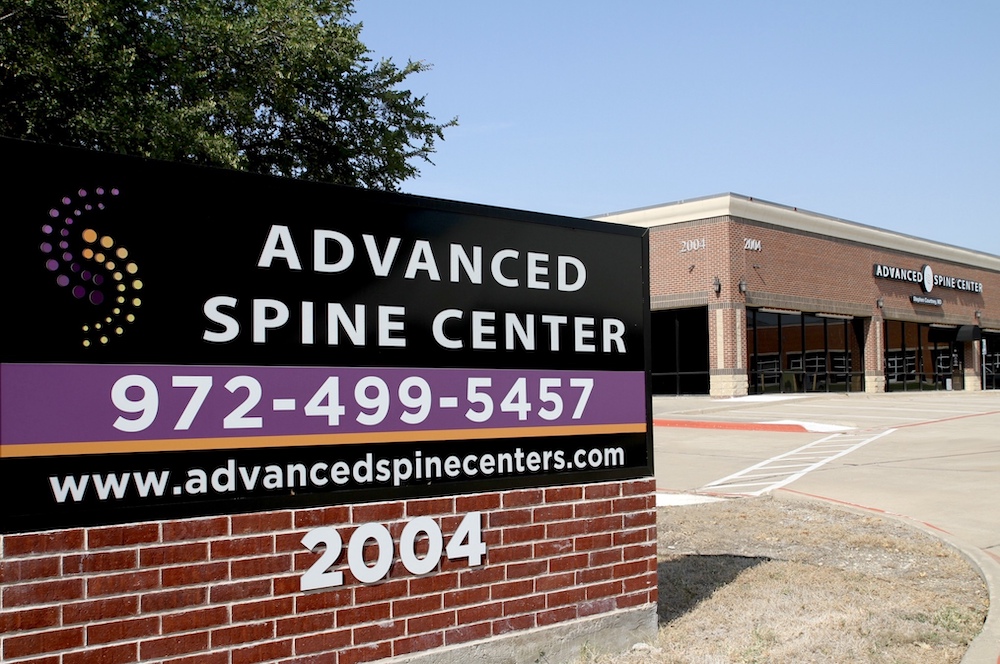Specialties
Minimally Invasive Lumbar Microdecompression Surgery

Minimally invasive lumbar decompression is an incredible surgical solution for those suffering from debilitating back pain. It is a minimally invasive procedure designed to alleviate pressure on the spinal nerves caused by conditions such as spinal stenosis, herniated discs, or degenerative disc disease. By employing advanced surgical techniques, this procedure aims to provide relief from pain and improve mobility while minimizing tissue damage and recovery time.
At the Advanced Spine Center in Plano, TX, we offer minimally invasive spine surgery solutions for patients battling chronic spinal pain. If you’ve been searching for a solution to your problem, look no further. Our board-certified orthopedic spine surgeons in Plano have extensive experience helping patients achieve relief from their pain. To schedule an appointment with us, please call our office today at 972-499-5457.
What Is Minimally Invasive Lumbar Decompression?
This minimally invasive procedure is used to remove overgrown vertebral bone and soft tissue to relieve the compression of nerve roots in the lumbar spine. It is a surgical procedure performed through a small incision on the back. Most commonly, surgeons employ this technique to treat spinal stenosis.
Types of Spinal Decompression Surgery
Spinal decompression surgery encompasses several techniques designed to alleviate pressure on the spinal cord or nerves. These techniques aim to address various spinal conditions that cause pain and discomfort. Below, we list some of the most common decompression surgical techniques.
- Minimally invasive lumbar decompression (MILD)
- Minimally invasive lumbar microdecompression (MILM)
- Laminectomy
- Lumbar microdiscectomy
- Lumbar spinal fusion surgery
How Serious Is Spinal Decompression Surgery?
As with any surgical procedure, spinal decompression surgery has certain potential risks. However, complications are rare due to advancements in surgical techniques and equipment. It is still considered a major surgery due to the nature of the procedure. The overall seriousness of the surgery depends on factors such as the type of procedure, the condition being treated, the procedure’s complexity, and the patient’s overall health.
What Is Lumbar Spine Decompression Used to Treat?

Generally, lumbar decompression surgery is reserved for cases where conservative treatments, such as lumbar epidural steroid injections, have failed to alleviate the patient’s pain. It is used to treat a range of conditions affecting the lower back, such as spinal stenosis, sciatica, and herniated discs.
MILD Procedure for Spinal Stenosis
One of the primary conditions treated with lumbar spine decompression is lumbar spinal stenosis. This is a condition characterized by the narrowing of the spinal canal or neural foramina and changes in the facet joints. Spinal canal narrowing can lead to compression of the spinal cord or nerves. This compression often results in symptoms such as back pain, leg pain, numbness, and weakness.
Lumbar spine decompression surgery aims to alleviate pressure on the spinal cord or nerves by removing excess bone or tissue and widening the spinal canal or neural foramina. This results in relief from symptoms associated with spinal stenosis.
MILD Procedure for Sciatica
Sciatica, another common condition treated with lumbar spine decompression, is characterized by pain that radiates along the sciatic nerve. This spinal nerve runs from the lower back down the back of each leg. This pain is often caused by nerve compression or irritation of the sciatic nerve roots in the lumbar spine.
This is typically due to conditions such as herniated discs, spinal stenosis, or degenerative disc disease. Lumbar spine decompression surgery can help alleviate pressure on the affected nerve roots, thereby relieving sciatic pain and improving mobility.
MILD Procedure for Back Pain and Leg Pain
Back and leg pain, whether chronic or acute, can also be addressed through lumbar spine decompression surgery. This pain may result from various conditions, including herniated discs, spinal stenosis, facet joint arthritis, or degenerative disc disease.
By relieving pressure on the spinal nerves and addressing the underlying cause of the pain, lumbar spine decompression surgery aims to achieve pain relief. This allows patients to resume their normal activities and improve their quality of life.
MILD Procedure for Herniated Disc
Herniated discs occur when the soft inner core of a spinal disc bulges out through a tear in the outer layer. They can cause significant pain and discomfort, as well as nerve compression.
Lumbar spine decompression surgery, such as microdiscectomy, involves removing the herniated disc material that is pressing on the spinal nerves. This relieves pain and restores function.
MILD Procedure for Pain in the Spinal Canal and Spinal Nerves
In cases where chronic pain originates from within the spinal canal or affects the spinal nerves directly, lumbar spine decompression surgery can help alleviate symptoms by relieving pressure on the nerves.
This may involve removing bone spurs, thickened ligaments, or other structures that are compressing the nerves within the spinal canal. By addressing the underlying cause of nerve compression, lumbar spine decompression surgery aims to alleviate pain and improve nerve function in the affected area.
What Are the Benefits of Minimally Invasive Lumbar Microdecompression?
Minimally invasive lumbar microdecompression offers several benefits compared to traditional open spinal surgery. This makes it an attractive option for patients seeking relief from lumbar spinal conditions. One significant advantage is the smaller incisions required for minimally invasive procedures. This results in less tissue damage, reduced blood loss, and a lower risk of complications such as infection and postoperative pain.
It also typically requires shorter hospital stays and faster recovery times compared to traditional open surgery. With less trauma to the surrounding muscles and tissues, patients undergoing minimally invasive procedures often experience quicker rehabilitation and a faster return to normal activities.
Another key benefit of minimally invasive lumbar microdecompression is its ability to preserve spinal stability and function. Minimally invasive microdecompression aims to address the underlying cause of symptoms while preserving as much of the natural anatomy as possible.
By selectively removing only the portions of bone or tissue causing nerve compression, minimally invasive microdecompression minimizes disruption to the spinal structure and helps maintain spinal stability and mobility.
Finally, minimally invasive techniques offer cosmetic advantages. The smaller incisions result in less noticeable scarring. Many patients are concerned about the appearance of scars, so minimally invasive techniques can help soothe these concerns.
How Is MILD Different from Traditional Back Surgery?
Minimally Invasive Lumbar Decompression
- Smaller incisions
- Reduced tissue damage
- Shorter recovery times
- Preservation of spinal stability
- Lower risk of complications
- Improved cosmetic outcome
- Outpatient procedure
Traditional Back Surgery
- Large incisions
- Extensive muscle dissection
- Longer recovery times
- Higher risk of complications
- Potentially extensive removal of bone and tissue
- Larger scars
- Longer hospital stays
Who Is a Candidate for Minimally Invasive Lumbar Decompression?

Candidates for minimally invasive lumbar decompression typically have symptoms associated with various spinal conditions that have not responded to conservative treatments. Chronic lower back pain, leg pain, numbness, weakness, difficulty walking, and decreased mobility are all symptoms that may indicate the need for surgery.
To determine if someone is a good candidate for the surgery, we will begin by taking a detailed medical history. It’s important that we understand which treatments the patient has already undergone for their pain. We also confirm that the patient is in generally good health.
How to Decompress the Lower Back with MILD Back Procedure
After general anesthesia has been administered and the patient is positioned face down, the surgeon uses a portable x-ray machine to identify the diseased vertebral level or levels. Then, the surgeon makes the smallest possible incision in the skin directly above the target level.
A series of dilators of increasing size are carefully guided down through muscles and soft tissue. The surgeon slides a tubular retractor over the dilators and removes the dilators, creating a working channel that leaves muscle tissue intact. This working channel allows the surgeon to access the target vertebra and painful nerve root in a way that minimizes incisional pain and scarring of the muscles.
The surgeon may use a microscope or endoscope to direct surgical instruments through the working channel. Excess bone or ligament tissue is carefully removed from the space around the nerve root, relieving pressure and pain.
The surgeon may then shift the working channel, repositioning the retractor so that it is directed at the other side of the vertebra. This allows the surgeon to access the opposite side of the vertebra without creating a new incision in the skin. The surgeon inspects and relieves any compression, ensuring that the nerve roots on both sides of the vertebra are completely free of obstruction.
The instruments and the working channel are removed, and the incision is closed and bandaged. Most patients are discharged from the hospital the same day and can return to their usual activity level within a few weeks of surgery. The patient may take pain medication to relieve incisional pain, but usually, this is needed for less than 1-2 weeks.
Spinal Decompression Surgery Recovery Time
In general, most patients can expect significant improvement in their symptoms within the first few weeks to months following surgery. This quick recovery time is due to the minimally invasive technique used to perform the procedure. Immediately after spinal decompression surgery, patients typically spend a brief period in the hospital for monitoring and pain management.
During that time, patients are encouraged to start moving and walking as soon as possible. This will promote circulation and prevent blood clots. Patients usually experience some discomfort or soreness at the surgical site. This can be managed with medication prescribed by their provider.
Once the patient is discharged, they will continue their recovery at home. Most patients gradually resume light activities within a few weeks after surgery. More strenuous activities should be avoided for a longer period, usually at least six to eight weeks.
Many patients feel able to return to their normal activities at the eight week mark. However, some patients have longer recovery periods. Full recovery may span six months to a year.
Physical Therapy After MILD Surgery
Physical therapy plays a crucial role in the recovery process following spinal decompression surgery. A structured physical therapy program helps patients regain strength, flexibility, and range of motion in the spine and surrounding muscles.
Physical therapists will tailor the exercise program to each patient’s specific needs and abilities, gradually increasing the intensity and complexity of exercises as the patient progresses in their recovery.
Physical therapy also teaches patients proper body mechanics and ergonomics to prevent future spine-related issues and promote long-term spinal health. By strengthening the core muscles and improving posture and body mechanics, physical therapy can help reduce the risk of recurrent symptoms and improve overall function and quality of life.
What Are the Potential MILD Procedure Complications?
While it is generally considered safe and effective, MILD carries potential risks and complications like any procedure. Complications are rare, but it’s important for patients to be aware of the risks so they can make informed decisions about their care.
Some potential complications associated with the MILD procedure include the following.
- Infection
- Bleeding
- Nerve or spinal cord injury
- Dural tear
- Failure to relieve symptoms
- Allergic reactions
Again, complications from the MILD procedure are relatively rare. Most patients experience significant relief from symptoms with minimal side effects.
Is It Normal to Have Pain After the MILD Procedure?
Yes, it is normal for patients to experience some pain or discomfort at the surgical site after their MILD surgery. However, pain management generally includes over-the-counter pain medications. If necessary, your provider may prescribe stronger medications.
What Is the Success Rate of Minimally Invasive Lumbar Decompression?

According to a 5-year study on the durability of MILD procedures, it saved 88% of patients from having to undergo more disruptive surgeries for their symptoms. MILD is preferable to other surgical treatment options due to its minimally invasive nature.
Contact the Advanced Spine Center for Minimally Invasive Spine Surgery Solutions
Minimally invasive lumbar decompression (MILD) surgery offers a revolutionary approach to treating lumbar spinal stenosis and associated symptoms such as back pain and leg pain. With its smaller incisions, reduced tissue damage, and faster recovery times compared to traditional open surgery, MILD provides patients with a highly effective treatment option that minimizes disruption to their daily lives.
By alleviating pressure on the spinal nerves through advanced surgical techniques, MILD can significantly improve mobility, reduce pain, and enhance overall quality of life for individuals suffering from lumbar spinal conditions. If you’re considering MILD surgery, consult with a qualified Plano spine specialist to determine if this innovative procedure is right for you.
To schedule an appointment with the Advanced Spine Center, please call our office at 972-499-5457 today.


